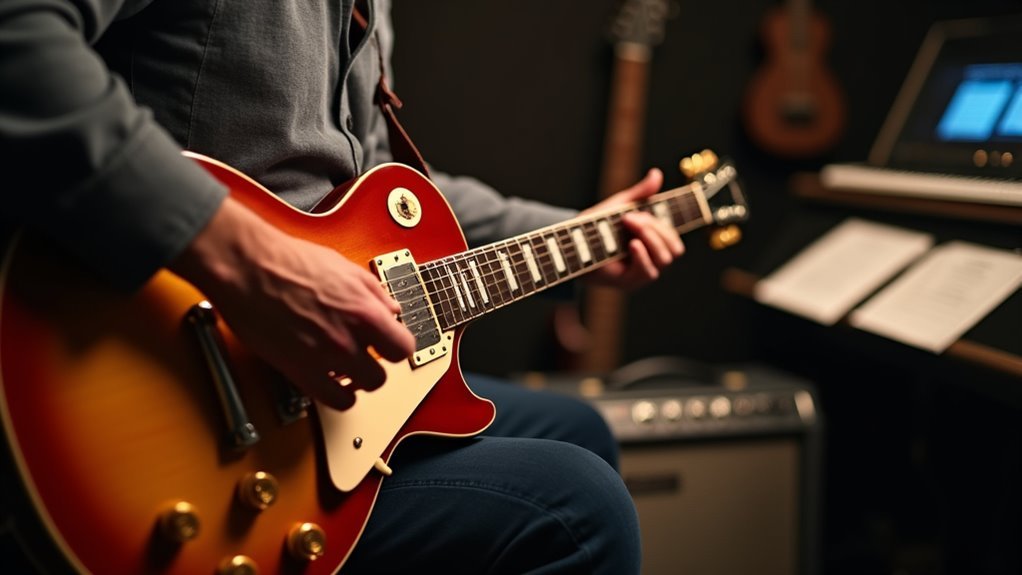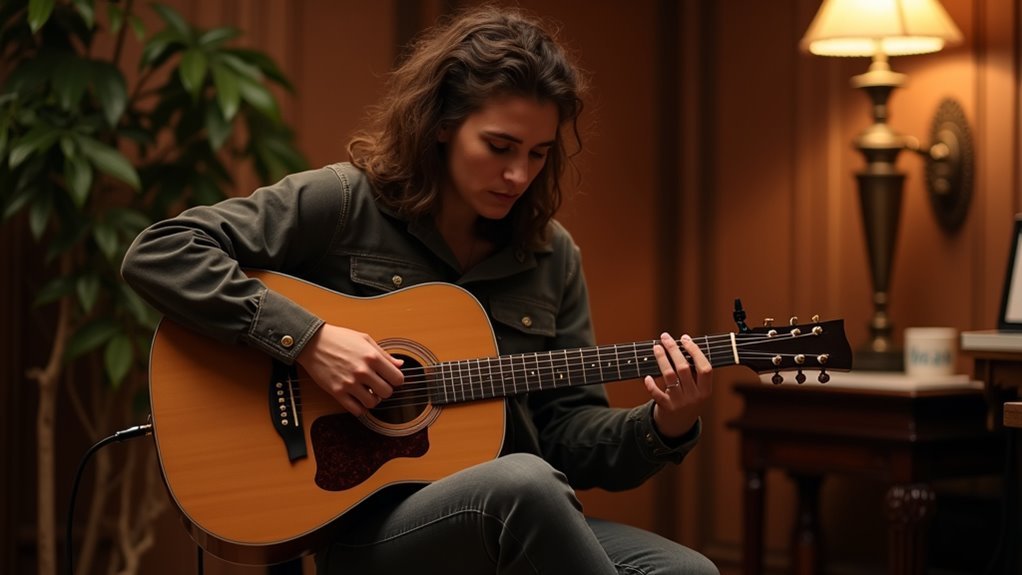When Pink Floyd’s “Dark Side of the Moon” haunts your ears, you’re hearing the Aeolian mode in action. We’ll show you how to master this essential guitar mode – from basic scale patterns to advanced melodic concepts. The natural minor scale isn’t just a collection of notes; it’s your gateway to crafting emotionally charged progressions and solos that cut straight to the soul. Let’s reveal the secrets of this powerful mode and transform your playing forever.
The Building Blocks of Aeolian Mode

Before we immerse ourselves in playing the Aeolian mode, we’ve got to nail down its fundamental structure.
Let’s cut to the chase: The Aeolian mode, your trusty natural minor scale, follows a specific interval pattern: W-H-W-W-H-W-W. That’s your blueprint for minor-key magic.
Think of it as seven essential scale degrees: root (1), major second (2), minor third (b3), perfect fourth (4), perfect fifth (5), minor sixth (b6), and minor seventh (b7).
This structure’s what gives you that classic minor sound every guitarist needs in their arsenal.
For improvisation and songwriting, you’ll start from your root note and follow this pattern.
Trust me – master these building blocks, and you’ll reveal the moody, expressive potential that makes the Aeolian mode a go-to for serious guitar playing.
Understanding Scale Patterns and Positions
Now that we’ve got the building blocks down, we’ll tackle the critical task of mapping out the Aeolian mode across your fretboard.
Let’s start with the A Aeolian scale pattern – find your root note at the 5th fret of the low E string. That’s your home base.
The pattern follows our essential whole-half step sequence: W-H-W-W-H-W-W. Master this, and you’ll reveal the scale degrees: root (A), major second (B), minor third (C), perfect fourth (D), perfect fifth (E), minor sixth (F), and minor seventh (G).
We’re not just memorizing positions here – we’re building a roadmap for improvisation.
Practice this pattern in multiple positions. The more comfortable you get with these scale positions, the more fluidly you’ll navigate the minor tonalities across your guitar neck.
Essential Chord Progressions in Aeolian

Moving from scale patterns to practical application, let’s explore the chord progressions that’ll define your Aeolian sound. The classic i-iv-v minor chord progression forms our foundation – it’s the bread and butter of modal melancholy.
We’ll enhance this with the VII major chord for powerful resolution back to tonic, and we’ll sprinkle in extended chords like minor 7ths and 9ths for deeper emotional depth.
- Master the essential i-iv-v progression first (Am-Dm-Em in A Aeolian) – it’s your gateway to modal expression
- Add the VII major chord for dramatic resolution (G major to Am)
- Experiment with modal interchange by borrowing from the parallel major scale
Try sustaining a drone note while working through these progressions. It’ll cement the unique sound of Aeolian in your mind and add gravitational pull to your playing.
Crafting Melodies Using the Natural Minor Scale
While chord progressions lay your harmonic foundation, it’s the natural minor scale that’ll give your melodies their distinctive Aeolian voice. Let’s master the WHWWHWW interval sequence to craft emotionally resonant phrases that captivate listeners.
| Element | Application | Impact |
|---|---|---|
| b6 Note | Emphasized motifs | Adds depth |
| Minor Pentatonic | Base structure | Improvisational freedom |
| Phrasing | Note groupings | Emotional expression |
Start with the minor pentatonic scale as your safety net, then weave in those characteristic Aeolian notes – especially that moody b6. We’ll create unique melodic ideas by experimenting with different note sequences. Remember, the natural minor scale isn’t just about playing sad tunes; it’s about crafting sophisticated motifs that tell a story through carefully chosen intervals and thoughtful phrasing.
Practice Exercises and Drills

These five essential practice exercises will transform your command of the Aeolian mode from theoretical to practical.
We’ll start with ascending and descending the A Aeolian scale while following the W-H-W-W-H-W-W interval pattern.
Let’s use a drone note to develop pitch awareness and establish our tonal center. For deeper theoretical understanding, we’ll call out scale degrees while practicing, cementing the mode’s unique characteristics in our minds.
- Combine scale practice with ear training by singing the notes as you play them
- Use jam tracks to develop your improvisation skills and craft compelling guitar solos
- Practice with a metronome at varying tempos to build rhythmic confidence
Applying Aeolian Mode in Different Musical Styles
Despite its ancient origins, the Aeolian mode remains a cornerstone of modern music, shaping everything from hard rock to ambient electronica.
Let’s explore how we apply this versatile minor mode across different musical styles.
In rock, we’ll find iconic songs leveraging the Aeolian mode’s emotional weight through powerful chord progressions. Try C Aeolian for that instant melancholic punch.
Jazz musicians, we’re looking at you – use these modal patterns to craft expressive improvisations that cut straight to the soul.
Singer-songwriters, the mode’s flattened thirds and sixths will amplify your lyrical impact tenfold.
For electronic music producers, the Aeolian mode creates the perfect atmospheric backdrop.
Layer those haunting melodies and watch how they transform your tracks into immersive soundscapes that grip listeners from start to finish.
Frequently Asked Questions
How Do You Play Aeolian Mode on Guitar?
We’ll start with scale exercises on the fifth fret, learn Aeolian scale patterns, and practice modal improvisation. Let’s incorporate chord progressions while focusing on proper finger positioning and ear training.
What Is the Formula for the Aeolian Mode?
Ready to reveal the Aeolian mode’s secrets? We’ll find its formula through the interval pattern WHWWHWW (whole, half, whole, whole, half, whole, whole), creating that distinctive natural minor scale sound.
What Is the Pattern of the Aeolian Mode?
We can remember the Aeolian scale’s pattern using WHWWHWW (whole, half, whole, whole, half, whole, whole), which creates fretboard patterns essential for melodic phrases and modal interchange in songwriting.
What Is Aeolian Mode Good For?
We’ll find endless melodic expression through Aeolian mode’s emotional resonance, perfect for songwriting inspiration and creating atmospheric soundscapes. It’s incredibly versatile across genres and delivers powerful musical storytelling opportunities.